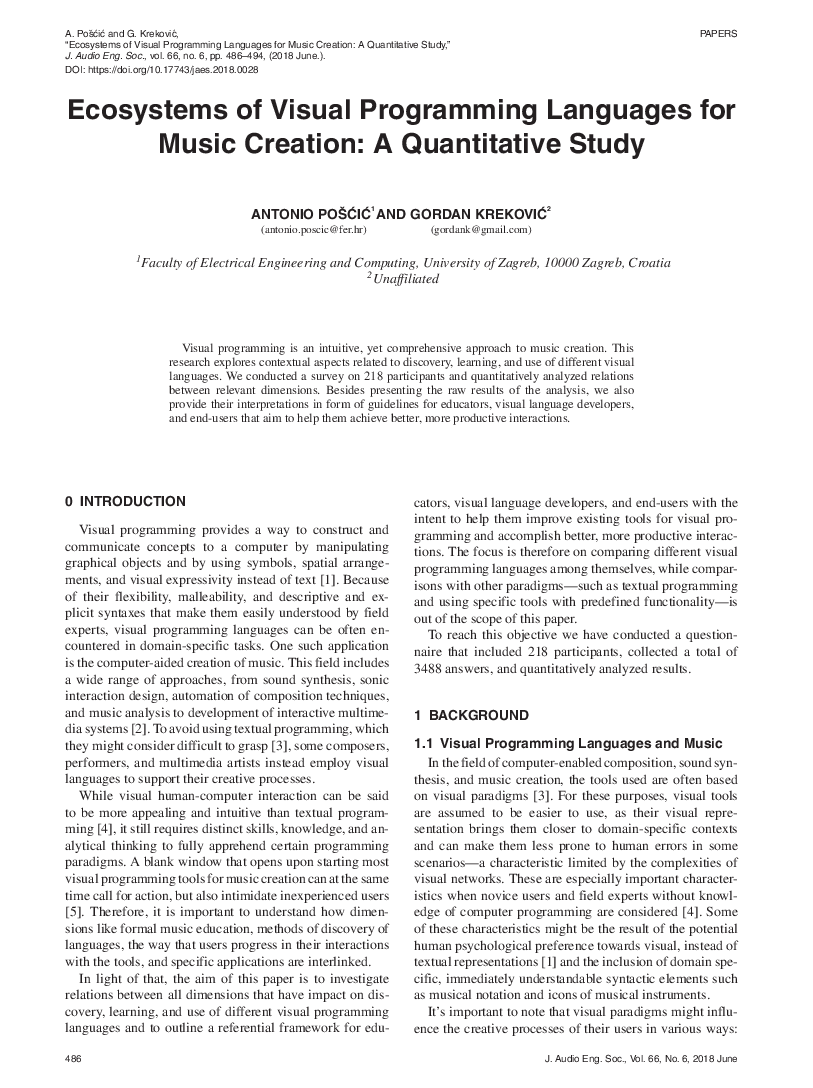Home / Publications / E-library page
You are currently logged in as an
Institutional Subscriber.
If you would like to logout,
please click on the button below.
Home / Publications / E-library page
Only AES members and Institutional Journal Subscribers can download
Visual programming provides a way to construct and communicate concepts to a computer by manipulating graphical objects and by using symbols, spatial arrangements, and visual expressivity instead of text. In context of music creation, it offers an intuitive yet comprehensive approach. To avoid using textual programming, some composers, performers, and multimedia artists employ visual languages to support their creative processes. This research explores contextual aspects related to discovery, learning, and use of different visual languages for music. The authors conducted a survey of 218 participants and quantitatively analyzed relations between relevant dimensions. The resulting interpretation of the analyzed data formed guidelines for educators, visual language developers, and end-users. Educators can use this research to improve how they transfer knowledge and mentor their students. Developers are provided with empirical evidence gathered through rigorous quantitative research that can indicate the existence of certain phenomena related to users of their tools. End users can engage in continuous and unstructured exploration and experimentation.
Author (s): Pošcic, Antonio; Krekovic, Gordan
Affiliation:
Faculty of Electrical Engineering and Computing, University of Zagreb, Zagreb, Croatia; Unaffiliated
(See document for exact affiliation information.)
Publication Date:
2018-06-06
Import into BibTeX
Permalink: https://aes2.org/publications/elibrary-page/?id=19588
(173KB)
Click to purchase paper as a non-member or login as an AES member. If your company or school subscribes to the E-Library then switch to the institutional version. If you are not an AES member Join the AES. If you need to check your member status, login to the Member Portal.

Pošcic, Antonio; Krekovic, Gordan; 2018; Ecosystems of Visual Programming Languages for Music Creation: A Quantitative Study [PDF]; Faculty of Electrical Engineering and Computing, University of Zagreb, Zagreb, Croatia; Unaffiliated; Paper ; Available from: https://aes2.org/publications/elibrary-page/?id=19588
Pošcic, Antonio; Krekovic, Gordan; Ecosystems of Visual Programming Languages for Music Creation: A Quantitative Study [PDF]; Faculty of Electrical Engineering and Computing, University of Zagreb, Zagreb, Croatia; Unaffiliated; Paper ; 2018 Available: https://aes2.org/publications/elibrary-page/?id=19588
@article{pošcic2018ecosystems,
author={pošcic antonio and krekovic gordan},
journal={journal of the audio engineering society},
title={ecosystems of visual programming languages for music creation: a quantitative study},
year={2018},
volume={66},
issue={6},
pages={486-494},
month={june},}